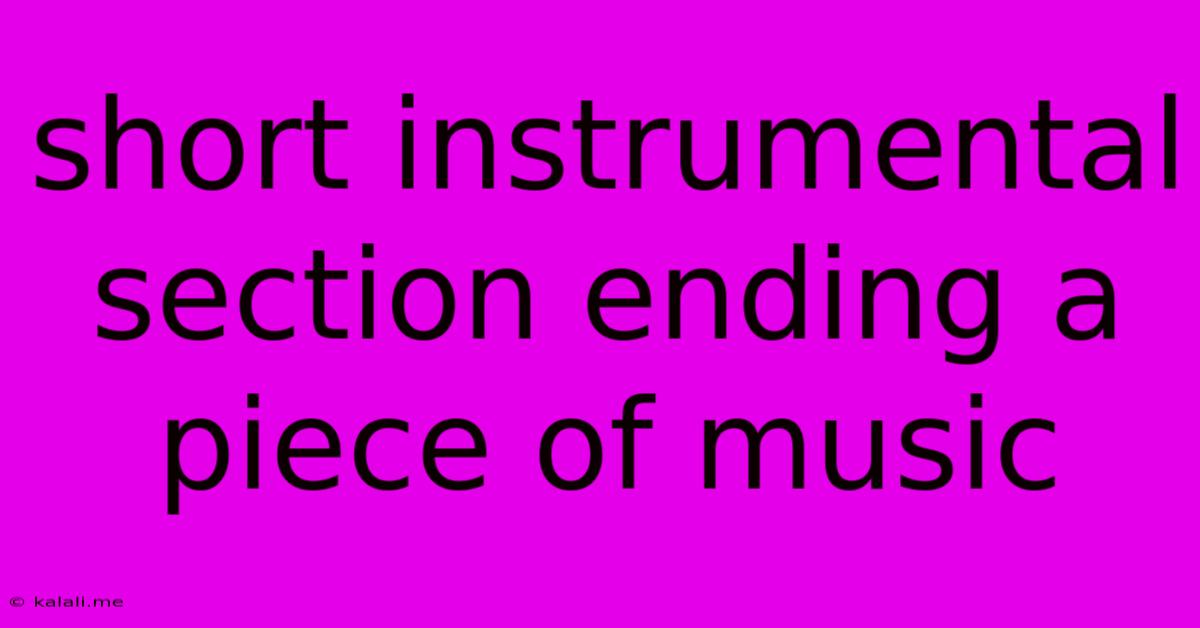Short Instrumental Section Ending A Piece Of Music
Kalali
Jun 04, 2025 · 4 min read

Table of Contents
The Art of the Short Instrumental Outro: Bringing Closure and Impact
The final moments of a musical piece can be just as crucial as the opening. A well-crafted ending leaves a lasting impression, providing a sense of closure and often amplifying the emotional impact of the entire work. One powerful technique is the use of a short instrumental section, often referred to as an outro, coda, or postlude, to gracefully bring the piece to its conclusion. This article explores the various functions and techniques involved in crafting a compelling and effective short instrumental ending.
A short instrumental outro offers a potent opportunity to summarize the piece’s themes, create a sense of resolution, or leave the listener with a lingering question. It allows for a gradual fade-out, a powerful climax, or a surprising twist, all depending on the composer's intent and the overall mood of the music. Understanding the nuances of its application can significantly elevate the impact of your composition.
Functions of a Short Instrumental Outro
-
Resolution and Closure: The most common function is to provide a sense of resolution. This might involve a return to the main theme, a simplified harmonic progression, or a gradual decrease in intensity, all leading to a satisfying conclusion. Think of the gentle fade-out often used in pop songs, providing a sense of peaceful completion.
-
Emotional Amplification: An outro can intensify the emotional impact of the preceding section. A sudden shift to a minor key, a dramatic crescendo, or the introduction of a new, emotionally charged melody can leave a powerful lasting impression. Consider the dramatic string swells often used in film scores to enhance the emotional weight of a scene.
-
Thematic Recapitulation: An outro can serve as a concise summary of the piece’s main themes. Short, fragmented motifs from earlier sections can be interwoven to create a sense of unity and coherence. This technique is frequently used in classical music, providing a sense of retrospective reflection.
-
Leaving a Lasting Impression: A short instrumental outro can create a memorable “hook” that lingers in the listener's mind. A unique melodic phrase, an unexpected rhythmic pattern, or a striking harmonic progression can leave a lasting impression long after the piece has ended.
-
Creating Ambiguity and Tension: Conversely, an outro can also be used to create a sense of ambiguity or unresolved tension. This might involve an abrupt ending, a dissonant chord, or a fading-out melody that leaves the listener with lingering questions. This technique often works well in dramatic or suspenseful pieces.
Techniques for Crafting a Short Instrumental Outro
-
Harmonics and Melody: Keep the harmonic progression simple and elegant. Focus on a few key chords that effectively summarize the piece's harmonic language. The melody, if present, should be concise and memorable, possibly echoing previous themes.
-
Dynamics and Tempo: Manipulating dynamics and tempo can significantly impact the emotional effect. A gradual diminuendo can create a sense of peaceful resolution, while a sudden crescendo can leave a powerful final statement. Similarly, slowing the tempo can heighten the emotional impact, while accelerating can create a sense of urgency or exhilaration.
-
Instrumentation: Choosing the right instruments can enhance the outro's emotional impact. A solo instrument can create a sense of intimacy, while a full orchestra can amplify the dramatic effect.
-
Texture and Rhythm: A simple, sparse texture might be appropriate for a quiet, reflective ending. A more complex texture with layered harmonies and counterpoint could provide a grand and powerful conclusion. The rhythmic patterns can also contribute greatly to the overall mood.
Examples in Different Genres
The use of short instrumental outros is prevalent across various genres. Classical music often features codas that summarize themes, while pop music frequently employs fade-outs to create a sense of closure. In jazz, improvisation often extends into the final moments, creating spontaneous and unpredictable endings. Electronic music utilizes various effects and soundscapes to generate unique and often experimental outros.
By carefully considering the overall mood, style, and narrative of your piece, you can create a short instrumental outro that enhances its impact and leaves a lasting impression on the listener. Experimentation and a keen understanding of musical techniques are key to mastering this art.
Latest Posts
Latest Posts
-
How To Wire Three Lights To One Switch
Jun 06, 2025
-
How To Know When Turkey Bacon Is Cooked
Jun 06, 2025
-
How To Remove Paint From Floor
Jun 06, 2025
-
Wire A 50 Amp Rv Plug
Jun 06, 2025
-
Did King Solomon Go To Heaven
Jun 06, 2025
Related Post
Thank you for visiting our website which covers about Short Instrumental Section Ending A Piece Of Music . We hope the information provided has been useful to you. Feel free to contact us if you have any questions or need further assistance. See you next time and don't miss to bookmark.